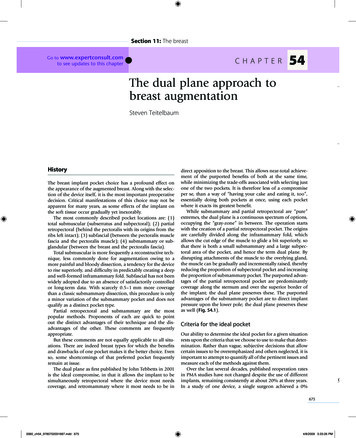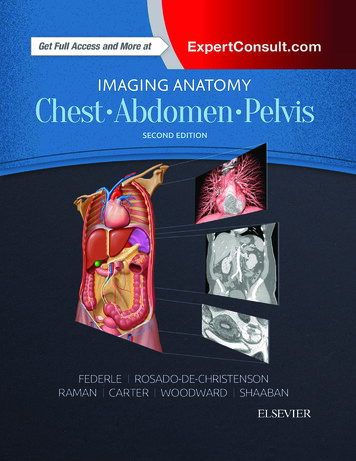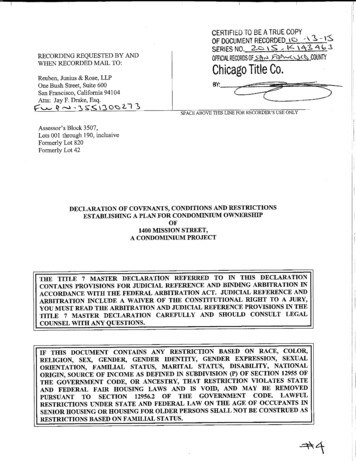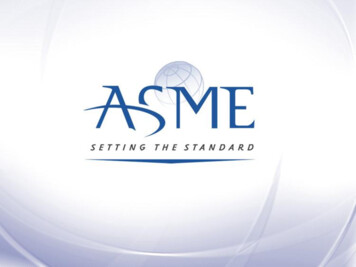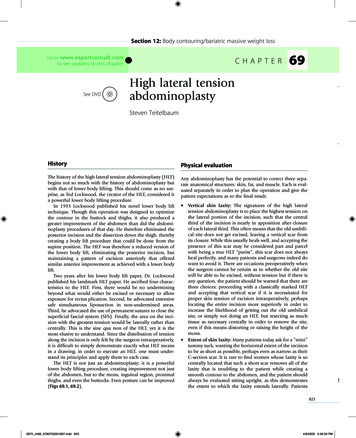
Transcription
Section 12: Body contouring/bariatric massive weight lossGo towww.expertconsult.comCHAPTERto see updates to this chapterSee DVD69High lateral tensionabdominoplastySteven TeitelbaumHistoryPhysical evaluationThe history of the high lateral tension abdominoplasty (HLT)begins not so much with the history of abdominoplasty butwith that of lower body lifting. This should come as no surprise, as Ted Lockwood, the creator of the HLT, considered ita powerful lower body lifting procedure.In 1993 Lockwood published his novel lower body lifttechnique. Though this operation was designed to optimizethe contour in the buttock and thighs, it also produced agreater improvement of the abdomen than did the abdominoplasty procedures of that day. He therefore eliminated theposterior incision and the dissection down the thigh, therebycreating a body lift procedure that could be done from thesupine position. The HLT was therefore a reduced version ofthe lower body lift, eliminating the posterior incision, butmaintaining a pattern of excision anteriorly that offeredsimilar anterior improvement as achieved with a lower bodylift.Two years after his lower body lift paper, Dr. Lockwoodpublished his landmark HLT paper. He ascribed four characteristics to the HLT. First, there would be no underminingbeyond what would either be excised or necessary to allowexposure for rectus plication. Second, he advocated extensivesafe simultaneous liposuction in non-undermined areas.Third, he advocated the use of permanent sutures to close thesuperficial fascial system (SFS). Finally, the area on the incision with the greatest tension would be laterally rather thancentrally. This is the sine qua non of the HLT, yet it is themost elusive to understand. Since the distribution of tensionalong the incision is only felt by the surgeon intraoperatively,it is difficult to simply demonstrate exactly what HLT meansin a drawing; in order to execute an HLT, one must understand its principles and apply them to each case.The HLT is not just an abdominoplasty; it is a powerfullower body lifting procedure, creating improvement not justof the abdomen, but to the mons, inguinal region, proximalthighs, and even the buttocks. Even posture can be improved(Figs 69.1, 69.2).Any abdominoplasty has the potential to correct three separate anatomical structures: skin, fat, and muscle. Each is evaluated separately in order to plan the operation and give thepatient expectations as to the final result. Vertical skin laxity: The signatures of the high lateraltension abdominoplasty is to place the highest tension onthe lateral portion of the incision, such that the centralthird of the incision is nearly in apposition after closureof each lateral third. This often means that the old umbilical site does not get excised, leaving a vertical scar fromits closure. While this usually heals well, and accepting thepresence of this scar may be considered part and parcelwith being a true HLT “purist”, this scar does not alwaysheal perfectly, and many patients and surgeons indeed dowant to avoid it. There are occasions preoperatively whenthe surgeon cannot be certain as to whether the old sitewill be able to be excised, without tension but if there isany question, the patient should be warned that there arethree choices: proceeding with a classically marked HLTand accepting that vertical scar if it is necessitated forproper skin tension of excision intraoperatively, perhapslocating the entire incision more superiorly in order toincrease the likelihood of getting out the old umbilicalsite, or simply not doing an HLT, but resecting as muchtissue as necessary centrally in order to remove the site,even if this means distorting or raising the height of themons. Extent of skin laxity: Many patients today ask for a “mini”tummy tuck, wanting the horizontal extent of the incisionto be as short as possible, perhaps even as narrow as theirC-section scar. It is rare to find women whose laxity is socentrally located that such a short scar removes all of thelaxity that is troubling to the patient while creating asmooth contour to the abdomen, and the patient shouldalways be evaluated sitting upright, as this demonstratesthe extent to which the laxity extends laterally. PatientsG8230075 ch69 9780702031687.indd 8234/8/2009 3:49:29 PM
Section 12: Body contouring/bariatric massive weight lossAesthetic Plastic SurgeryFig. 69.1 With the high angle of the lateral portion of the incision with the HLT, the thigh looks longer. Note the improvement of the quality of skin in thethigh and inguinal region. The abdomen is smooth and tight, and thought he slit used to close the abdomen has widened with time.can understand that if the laxity extends to the mid-axillary line that an incision the width of her previous Csection will fail to correct the lateral laxity. Even comparedto the standard abdominoplasty, the HLT does require awider incision. That is because the standard tummy tuckis essentially an exercise in “excising the umbilicus”; thewidth of the incision is determined according to oneparameter: how much is necessary to remove that verticalexcess without creating a dog-ear. But the HLT considersthat lateral excess the most important area for excision. Bypulling down and out laterally, a greater degree of flattening of the epigastrium occurs than pulling simply straightinferiorly. This can easily be demonstrated to a patient bycreation of downward tension on the epigastrium bypinching between the umbilicus and just above the mons,and contrasting that with the greater improvement thatoccurs to the epigastrium by simultaneously pinchinglateral, angled down and out, so that the epigastrium isbeing pulled in two directions. The greatest laxity on thetrunk of the post-partum or weight loss patient is alsolaterally, so this area needs the greatest amount ofexcision. Skin quality and texture: Just like with a mastopexy, afterskin is removed, the same skin that stretched once andGwas damaged remains behind. The ultimate quality of theresult and appearance will be based upon the patient’sown skin, for which we have little if any control. It isimportant to asses the skin in order to give the patientexpectations as to what their particular outcome is likelyto be. Do stretch marks still exist superior to the likely lineof resection so that many will remain, or are they likelyto all be excised? Is the skin thin and/or sun-damaged,likely to reloosen to a significant degree or have notablelines or wrinkles? These issues must all be addressed withthe patient preoperatively in order to set their expectations, and patients should further realize that there is nopreoperative test that can predict how their particular skinwill hold up after surgery; the best a surgeon can do isoffer them an educated guess. The presence of pre-existingabdominal scars must be assessed as they may haveaffected blood supply in such a way so as to necessitatemodification of the HLT design, or to limit underminingeven more than usual. Occasionally the scar is adherentto the underlying abdominal wall and considerationneeds to be given to whether the scar needs to be freed toallow transfer of tightening forces beyond it, or whethersuch a maneuver would compromise blood supply. Thereare also sometimes transverse lines of adhesion, usually8240075 ch69 9780702031687.indd 8244/8/2009 3:49:29 PM
Chapter 69 High lateral tension abdominoplastyFig. 69.2 Note the dramatic rejuvenation of the entire truncal unit, including the inguinal region and proximal thighs. Note also the more youthful pelvic tiltas described by Lockwood.between umbilicus and xyphoid between the midline andthe anterior axillary line that prevent transference of pullfrom the abdominoplasty to the tissues cephalad to it. Itcan take substantial undermining to free these up, and indoing so the blood supply to the flap can be compromised. These issues need to be discussed with the patientpreoperatively. Excess fat within flap: The HLT allows for safe suctioningof the abdominoplasty flap. The flap should be evaluatednot just for the presence of significant subcutaneous fat,but for the extent to which this fat is proportional to thepatient’s overall body habitus. Most important is notingthe thickness at the expected level of flap transection relative to where that tissue will be sewn inferiorly. It is frequently much thicker superiorly, and liposuction of theflap should be considered to create a smooth transition. Itend to suction abdominaplasty flaps only occasionally.The patient population I predominantly see is thin. Moreover, though liposuction of the flap can be done safely, itdoes seem to increase the likelihood of seroma formationand prolong recovery. Excess fat in contiguous areas: When a patient seems tohave a large amount of fat in their abdominal flap, thereis usually an even greater amount of fat in the pubic areaor the posterior iliac crest area. Too much is made ofliposuctioning of abdominal fat within the flap. Oftentimes, there is not enough to remove to make a significantdifference in the appearance. Usually, the hips containsubstantially more fat in proportion to the abdomen. Ifthere is a lot to remove in the abdomen, there is usuallymore in the hips or the thighs, and it is important to lookat those areas and consider treating them, lest the surgeoncreate a disharmonious proportion. With the abdomenflattened from an abdominoplasty, the width that resultsfrom excess hip fat can be very apparent. In fact, by tightening the abdomen, the width of the hip area can appearto increase following an abdominoplasty (Fig. 69.3). Narrowing the waist through suction of the posterior hip rollcan dramatically improve the appearance of the abdomen.Similarly, excess fat in the mons area is often not notedpreoperatively. Either the abdomen may be protuberantor there may be tissue overhanging the waist. After asmooth and flatter abdomen, the mons can protrude inclothing and be disconcerting. This can be treated withliposuction at the time of abdominoplasty and this areashould be assessed for this preoperatively. Rectus diastasis/hernia: The patient should be examinedstanding, sitting, and laying back flat while raising herG8250075 ch69 9780702031687.indd 8254/8/2009 3:49:33 PM
Section 12: Body contouring/bariatric massive weight lossAesthetic Plastic Surgerythere to be relapse in any situation, this is certainly exacerbated in cases in which there is the greatest degree ofintra-abdominal fat. This is important because it mightweigh on your choice as to whether or not there is enoughof a benefit from plication to make it worth the additionalrecovery. Also, it helps to warn patients about an increasedpossibility of the repair loosening and restretching withtime.AnatomyBlood supplyFig. 69.3 Even the slightest hip bulges such as this should be treated withliposuction lest the waist appears more square following an HLT. Note alsothat the scar is wide enough to be noticeable from the postoperative PAview on the bottom.shoulders up, as in doing a partial sit-up. This is a goodway to test for a rectus diastasis. From this position, onecan take the patient’s hands and show them the gap thatexists between their muscles. Some patients will commentthat they need “to work out more.” But they need to bereassured that exercise will only increase the strength ofthe muscles; only surgery can bring them back together. Ialways discuss with patients that they have an option ofwhether or not to plicate any diastasis. While the plicationcan substantially improve the outcome, so too does itlengthen the recovery and make it more uncomfortable.The umbilicus is always assessed for the presence of afascial defect that may need to be repaired either separately or at the time of abdominoplasty. The patientshould also be examined in profile with her arms at hersides and above her head, asking her to allow her abdominal musculature to relax. During plication, it is all tootempting to tighten her as much as possible from pubisto xyphoid; more important is to assess the patient’s laxityand preplan where the abdomen needs to be tightened tocreate the most attractive contour. Intra-abdominal fat: Pressure from the internal organsincluding intra-abdominal fat puts pressure on any repairthat is done of the rectus diastasis. While it is possible forGPlastic surgery is indeed the battle of beauty versus bloodsupply whenever an undermined flap is involved, and fewsuch flaps involve the degree of undermining as does theabdominoplasty flap. Fortunately, the rich blood supply combined with the limited undermining shown by Lockwood inhis description of the HLT usually results in the creation ofan excellent cosmetic result free from healing problems secondary to vascular insufficiency.Prior to surgery, the abdominal wall is densely supplied byvessels coursing inferiorly and medially from the superiorepigastric artery, the subcostal artery, and lumbar branches.These anastamose with vessels ascending superiorly from thedeep and superficial epigastric vessels.These anastomoses are obviously disrupted with theabdominoplasty, leaving the flap to be supplied by the superior vessels that are coursing downward. The blood supply ofthe inferior cut edge is not undermined and can be closedunder great tension with no issue of devascularization.But the superior edge is dependent upon these vesselscoursing inferiorly. While the flap is robust, there is little ifany cosmetic advantage to any more undermining than necessary to complete the resection and expose the area needed forplication; irregularities seen on the table will flatten outpostoperatively.The skin/adipose layerMost patients requesting an abdominoplasty have compromised skin as they are typically either post-partum, postmassive weight loss, or both. These make permanent changesto the skin that will affect the final outcome. Notation shouldbe made of the extent, color, and severity of the striae. Redderstriae seem to be predictive of a redder final scar. Striae superior to the anticipated cut edge of the flap will obviouslyremain following surgery.It is not enough to just evaluate the skin of the abdomen.The HLT is actually a body lifting procedure, and it can significantly tighten and rejuvenate the mons, inguinal region,and proximal thigh. These areas should be assessed for laxityand the potential for improvement.It also must be appreciated that there is both horizontaland vertical excess of the skin/subcutaneous fat layer. Thehorizontal scar of an abdominoplasty obviously reduces thevertical excess, but what about the horizontal excess? Usuallythe body is wider at the height of the lower abdominoplastyincision than it is at the upper abdominoplasty incision, so8260075 ch69 9780702031687.indd 8264/8/2009 3:49:37 PM
Chapter 69 High lateral tension abdominoplastythat when the edges are closed, the horizontal excess is apparently eliminated. But there is not a significant change in widthof the abdomen from the level of the xyphoid down to aboutthe level of the umbilicus; in fact, the body often narrows.What this means is that the tissue that is transferred downfrom the upper to the mid-abdomen during a tummy tuckdevelops even greater horizontal laxity when a traditionalabdominoplasty is done, as the incision is relatively parallelto the ground and the greatest pull is straight inferiorly. Butwith the HLT, the lateral limbs of the final closure divergesuperiorly in an oblique direction, and they hold the greatestamount of tension. This serves to excise that horizontalredundancy in the epigastrium, thereby flattening it and significantly improving the abdominal contour.The abdomen as well as these areas should be assessed forlaxity and the presence of fat, will determine how wide theincision will need to be, and the direction of greatest laxitywill ultimately affect the angle of the lateral limbs of the HLT,as tension will obviously be greatest perpendicular to thoseangles. Lockwood has shown that the greatest redundancy isusually laterally rather than centrally. While high centraltension distorts the mons, high lateral tension smooths outthe inguinal region and proximal thighs, and confers greatersmoothing effects to the epigastrium than does high centraltension.Musculofascial layerThe abdominal wall itself is made of four major paired musclegroups: the transversus abdominis, the external oblique,internal oblique, and rectus abdominis muscles. Ideally, therectus sheath that envelopes the rectus muscles fuses in themidline, forming a narrow and stout structure that maintainsjust a few mm separation between the muscles. However withpregnancy, and to a lesser extent weight loss, the linea canattenuate and stretch, allowing the distance between themuscles to separate. This is easiest to examine when thepatient does a sit-up. Whatever gap is noted during thatmaneuver is amplified when the patient stands upright andthe pressure of the viscera is applied to the uncontractedabdominal wall. A rectus diastasis is only a gap; it is not synonymous with a hernia. A true midline hernia is extremelyrare in the absence of a previous midline laparotomy incision.Quite common, however, is an umbilical hernia. Everyabdominoplasty patient should be examined to assess for thepresence of one. Deep within the base of the umbilical stalk,a fascial defect can be felt at the time of exam. This is important as it can worsen with time. Once noted, it should bepointed out to the patient at the time of consultation, and ifultimately she does not wish to undergo an abdominoplasty,she should be advised to seek consultation with a generalsurgeon for repair of the hernia.Technical stepsSee Fig. 69.4.Photography should be done in a complete and consistentmanner. All patients should have photos of the entire aes-thetic area from the shoulder to knee. Sometimes when theview is too cropped, the effect of the result on the patient’soverall physique is not as noticeable as when there is a widerview. Images should be taken both AP and PA, both laterals,and all four obliques. Photos should always be taken withthe patient sitting, particularly if the patient is thin and thereis not significant skin redundancy appreciated when standing(Figs 69.5–69.7). Frankly, the abdomen always looks muchworse in a seated photo, but this is a position in which wespend much of our lives, and the exaggeration of abdominalredundancy noted in this position must be reckoned with.The photos do not just force the surgeon to notice everythingrelevant to the surgery and act as a basis for discussion withthe patient, but they serve a critical role of demonstrating forthe patient the rationale for the surgery down the road shouldthey question the width of the scar or the extent of improvement. Standardized photos can do much to allay patientconcern and anxiety. The recovery from the procedure is longand there are often times in which a patient asks themselveswhether it was worth it; seeing the original picture can be veryhelpful for them. If the scar ends up wide or thick, the photoscan remind the patient that the scar is less problematic thantheir laxity.Determining the position of the incision is the most criticalpart of the operation. Always bear in mind two often conflicting forces: the surgeon’s determination of what scar will createthe best contour, and the patient’s wishes for the location ofthe scar.Oftentimes, the surgeon would like the lateral limbs of aHLT scar to elevate more superiorly laterally than the patientwants. I have never had a patient complain that I didn’t createa “harmonious” appearance to their abdomen, touted as anadvantage of the HLT by Lockwood. But I have had patientscomplain that the lateral part of the scar was exposed abovelow riding jeans or bikinis. Patients need to understand thatthe upward angle of the scar allows for greater flattening ofthe epigastrium and overall contour than a more horizontalscar. While I believe that a significantly convex scar creates amore pleasing contour, I have become increasingly willing tomake the scar more horizontal in order to satisfy patientrequest. While I have seldom had a patient complain that Icould have created “a more aesthetic trunkal unit” – a goalof the HLT – I have had complaints about the scar extendingabove low riding jeans.The patient wears a bikini bottom or underwear that istypical of the style she likes to wear. Frequently, patients arenow wearing underwear that is relatively horizontal, preventing the scar from rising laterally as much as necessary to createhigh tension that pulls obliquely from each lateral limbagainst the epigastrium, thereby forcing the scar to be lowerand more horizontal than optimal for giving the patient thebest possible contour. There are two ways to deal with this.First, one can advise the patient that a higher scar laterallywill give a better appearance to the abdomen, which is usuallythe biggest concern to the patient. But it is also true that styleschange, and sooner or later swimsuits and underwear willride up higher again on the hips, meaning that a low scarwould be visible in even one-piece suits. However, a high scarthat is optimal for an HLT will always be covered by a one-G8270075 ch69 9780702031687.indd 8274/8/2009 3:49:40 PM
Section 12: Body contouring/bariatric massive weight lossAesthetic Plastic SurgeryABCDEFFig. 69.4 A, The outline of a typical pair of the patient’s panties is drawn. Then the proposed final scar location is drawn (as shown here by the dotted blueline). With the pen held at the level of that line, the skin is pushed cephalad with the expected amount of tension on the closure at that area to determinewhere the initial incision must be made for the final scar to end up at that dotted line. B, The patient is marked, measured, and checked multiple times forsymmetry. C, I have found it difficult to draw straight lines while holding a tape measure flat against the body; use of 2-inch tape has facilitated the ability todraw straight lines. D, Using the tape to checkerboard the stomach greatly facilitates drawing even lines of resection intraoperatively and makes final closuremore precise. E, There should be about 7 cm of hairbairing skin on stretch above the anterior vulvar commissure. F, The PlasmaJet used to paint the entire rawsurface, reducing bleeding and sealing lymphatics, thereby reducing the time a drain is necessary and reducing the likelihood of seromas.G8280075 ch69 9780702031687.indd 8284/8/2009 3:49:40 PM
Chapter 69 High lateral tension abdominoplastyGHIJKLFig. 69.4, cont’d G, The Lockwood D’assumpco clamp is used to mark the extent of resection. It is critical to pull on the flap in the direction that it will beclosed and with the amount of tension that you wish to put on that part of the flap. There is less tension placed centrally, as high tension would distort themons. More tension is used laterally. After hash marks are made with the table flexed at about 30 degrees, the patient is laid flat, and the final resection line ismade, using the checkerboard to assess symmetry. H, Final resection. Note not just the obviously greater resection laterally than centrally, but that in fact thelateral resection is just a bit more than the central resection (see resection relative to original preoperative horizontal line from the preoperative markings). Alsonote that even the upper line seems to drop inferiorly centrally, while the more lateral part of what was once a horizontal line rises up laterally. This is part ofthe confusion of the HLT. While in fact there is more taken laterally than centrally, it is only a bit more, not a lot more. Most of what appears to be a greateramount taken laterally is really due to the way the tissue is adherent to the deeper structures. I, The vertical lines are extremely helpful in arranging a speedyand well-aligned closure. Note the umbilicus marking clamp; the deep side of the clamp is around the umbilical stalk, and the other side can be used to markexactly where that is transferred to the front. J, It is important for the closure to incorporate a sturdy bite of the cut edge of the SFS. The layer is always morestout in the inferior cut edge than the superior edge. It tends to retract a significant degree in the central third of the abdomen, and one needs to really.K, Though usually less obvious than in the inferior edge, there is a prominent SFS in the superior flap. #1 Nurolon soaked in Betadine is used to make a tightdeep closure, taking all the tension off of the skin. L, Liposuction is performed at the end of the incision to reduce dog-ear and bulk in all but the thinnest ofpatients. The extreme lateral tension requires that the incision be lengthened, but even with that, there still tends to be a thickening at the waist if the extra fat829is not removed.0075 ch69 9780702031687.indd 8294/8/2009 3:49:48 PMG
Section 12: Body contouring/bariatric massive weight lossAesthetic Plastic SurgeryMNOPFig. 69.4, cont’d M, The Insorb subcuticular stapler has reduced closing times and made the wound edges more evenly approximated. Because of thedouble Adson forceps, it can help to smoothly redistribute mismatches in lengths of the two flaps. Reducing operative time is an important part of reducingDVT and PE risk, and the fact that scars are at least as good with this as with sutures argue strongly for its adoption. N, With the HLT, the greatest tension islateral. When it is closed, the incision above the pubic area almost comes together without a clamp in the area. This maximally rejuvenates the thighs as wellas the epigastrium, applying an oblique angle of tension to the epigastrium from each limb. The incision angles up more than a standard abdominoplasty inthe lateral area, and it also extends wider into the flank in order to not have a dog ear from the large lateral resection and tension that is thereby created.O, Closure with a traditional abdominoplasty pulls most of the tension centrally. The only improvement to the epigastrium is that which occurs from thestraight downward tension, and there is no oblique lines of tension pulling on the thighs and epigastrium as there is with the HLT. P, This patient is lyingsupine. The horizontal lines were drawn straight with a laser level, yet they are pulling up somewhat from the midline. Once the flap is released along thelower incision, this happens to an even greater extent, thereby accentuating the perception of the extent of lateral tension. In reality, the resection is often onlya little bit more laterally than centrally with an HLT (blue line). But with a standard, the surgeon is usually focused on just “getting out” the old umbilical site,and the length of the incision is that which is dictated to close it without skin redundancy (green line). Therefore, the standard usually does not have as wideof an incision as does the HLT. Though the HLT resection drawn in blue here was able to be done on this patient, the HLT frequently results in non-excision ofthe umbilicus. So long as there is sufficient lateral tension, there will not be laxity and redundancy in the epigastrium. One must be diligent about creatingadequate lateral tension, and be willing to extend the incision as far laterally as necessary to accomplish this.G8300075 ch69 9780702031687.indd 8304/8/2009 3:49:54 PM
Chapter 69 High lateral tension abdominoplastyFig. 69.5 Muscle wall laxity, skin redundancy, and fat excess should all beassessed and documented.Fig. 69.6 The same patient leaning slightly forward; it is not enough toexamine a patient standing. Standing is good for assessing adipose deposits,but laying flat and doing a sit-up is important for assessing the muscles, andsitting down and bending forward is crucial for assessing skin laxity.GFig. 69.7 There is always significant scar with any abdominoplasty; document the patient in a position that most shows the deformity to be shown to themlater. Note that the vertical scar is still in somewhat of a slit; this will spread over the course of a year or more and become more round.8310075 ch69 9780702031687.indd 8314/8/2009 3:49:57 PM
Section 12: Body contouring/bariatric massive weight lossAesthetic Plastic Surgerypiece and will be above it and visible only with a low onepiece. Ultimately, the patient must know what to expect withthe scar. The other option when the patient wants the scarslow is to make the scar lower above the mons, which allowsone more room to let the scar course more superiorly up tothe lateral ends of the incision. But one must be careful notto remove too much hair-bearing skin in the pubic region;generally it should be about 6.5–7 cm from the anterior labialcommissure to the top of the pubic hair on maximum stretch.And the other problem with lowering the scar centrally is thatit makes it that much more likely that the old umbilical sitewill not be able to be excised, and that a short vertical scar toclose it will remain in the infraumbilical/suprapubic region.While most all facelifts can begin with a similar initial incision around the ear, varying only in final skin excision, theinitial abdominoplasty incision lacks the concrete anatomicallandmarks of the ear, and given various abdominal configurations and patient wishes, the initial incision must be customized to each patient.The midline is marked from xyphoid to umbilicus to thelabial commissure. While it is embarrassing to mark this,many women today have pubic hair that is trimmed unevenly,so that drawing a line to the center of the pubic hair can resultin a crooked inset of the flap. I then draw a number of verticallines parallel to the first line from the midline going out laterally to where the incision is expected to end (Fig. 69.8). Additional horizontal lines are drawn to create a checkerboard onthe abdomen. This helps not just at this point while markingthe patient, but it makes for a much more rapid determination of final resection, reduc
Go to www.expertconsult.com to see updates to this chapter 00075_ch69_9780702031687.indd 823075_ch69_9780702031687.indd 823 44/8/2009 3:49:29 PM/8/2009 3:49:29 PM. G Section 12: Body contouring/bariatric massive weight loss Aesthetic Plastic Surgery 824

